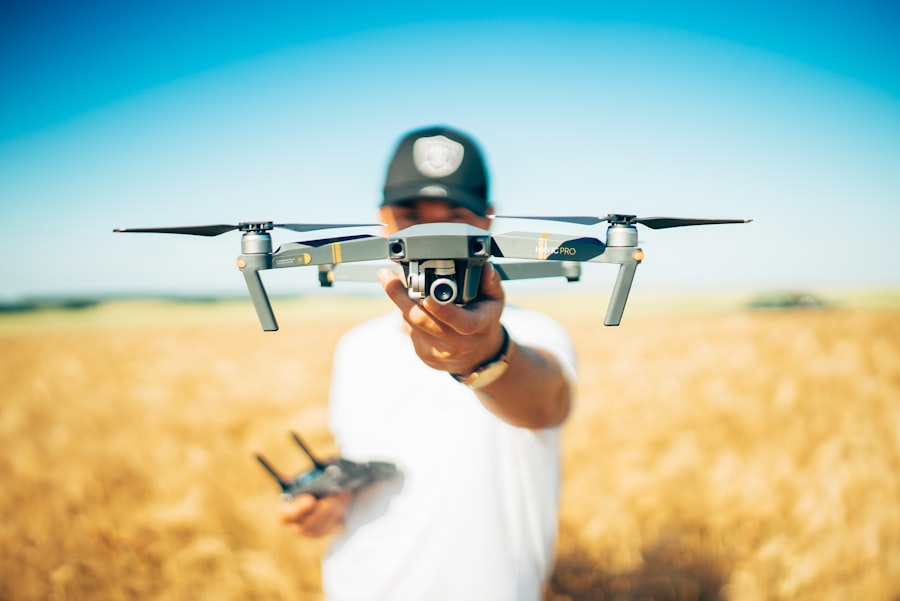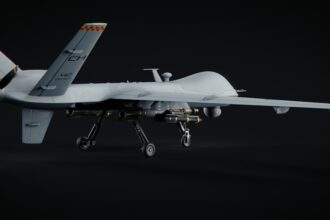In recent years, the emergence of small drones has revolutionized various sectors, particularly in military operations. These compact, unmanned aerial vehicles (UAVs) have gained prominence due to their versatility, affordability, and ease of use. Unlike their larger counterparts, small drones can be deployed quickly and with minimal logistical support, making them an attractive option for modern warfare.
Their ability to gather intelligence, conduct surveillance, and even deliver payloads has transformed the battlefield landscape, allowing for more strategic and tactical advantages. The proliferation of small drones has not only changed how military forces operate but has also influenced the dynamics of power among nations. As these devices become more accessible, both state and non-state actors are increasingly incorporating them into their arsenals.
This shift raises important questions about the future of warfare and the implications of integrating such technology into military strategies. Understanding the advantages and limitations of small drones compared to traditional big weapons is essential for grasping their role in contemporary conflicts.
Key Takeaways
- Small drones are becoming increasingly popular in military operations due to their versatility and cost-effectiveness.
- Small drones offer advantages such as agility, stealth, and the ability to access hard-to-reach areas, making them valuable assets in reconnaissance and surveillance missions.
- Big weapons, while powerful, have limitations such as being bulky, expensive, and less adaptable to changing battlefield conditions.
- A case study of a small drone outsmarting a big weapon highlights the effectiveness of small drones in evading traditional defense systems.
- Small drones use tactics such as swarming, autonomous navigation, and low-altitude flying to outmaneuver big weapons and disrupt enemy operations.
Advantages of Small Drones
One of the most significant advantages of small drones is their cost-effectiveness. Unlike larger military aircraft or missile systems, which require substantial investment in terms of development, maintenance, and operation, small drones can be produced at a fraction of the cost. This affordability allows military forces to deploy multiple units simultaneously, creating a swarm effect that can overwhelm enemy defenses.
Additionally, the low operational costs associated with small drones enable prolonged missions without the financial burden typically associated with larger weapon systems. Another key benefit of small drones is their agility and maneuverability. These UAVs can navigate through complex environments, including urban settings where traditional aircraft may struggle.
Their small size allows them to fly at lower altitudes and evade radar detection more effectively than larger aircraft. This capability is particularly advantageous for reconnaissance missions, where stealth and the ability to gather real-time intelligence are paramount. Furthermore, small drones can be equipped with various sensors and cameras, enhancing their operational versatility and enabling them to perform a wide range of tasks from surveillance to target acquisition.
Overview of Big Weapons

Big weapons, such as fighter jets, bombers, and missile systems, have long been the backbone of military power. These formidable machines are designed for high-impact operations and can deliver devastating firepower over vast distances. Their advanced technology often includes sophisticated targeting systems, high-speed capabilities, and substantial payload capacities.
As a result, big weapons have traditionally been viewed as essential components of a nation’s defense strategy. However, the reliance on big weapons comes with its own set of challenges. The complexity of operating these systems requires extensive training and resources, which can strain military budgets.
As warfare evolves, the effectiveness of traditional big weapons is increasingly being called into question, leading military strategists to explore alternative solutions that can complement or even replace these conventional systems.
Limitations of Big Weapons
| Limitations | Impact |
|---|---|
| Cost | High cost of development and maintenance |
| Mobility | Difficulty in transporting and deploying |
| Accuracy | Challenges in precision targeting |
| Civilian Casualties | Risk of collateral damage |
Despite their impressive capabilities, big weapons are not without limitations. One major drawback is their high operational cost. The expenses associated with maintaining and operating large military aircraft or missile systems can be astronomical, often diverting funds from other critical areas within a military budget.
This financial burden can limit the number of units a nation can deploy, potentially leaving gaps in defense coverage. Moreover, big weapons are often less adaptable in dynamic combat situations. Their size and complexity can hinder rapid deployment and response times, making them less effective in scenarios that require quick decision-making and flexibility.
In contrast to small drones that can be launched from various platforms and locations with minimal preparation, big weapons may require extensive logistical support and infrastructure.
Case Study: Small Drone Outsmarting a Big Weapon
A notable example illustrating the effectiveness of small drones against big weapons occurred during a recent conflict in the Middle East. In this scenario, a small drone was deployed by a non-state actor to conduct surveillance on a heavily fortified military base equipped with advanced missile defense systems. The drone’s operators utilized its agility and stealth capabilities to navigate through the base’s defenses undetected.
As the drone gathered intelligence on troop movements and equipment placements, it transmitted real-time data back to its operators. This information allowed them to plan a targeted strike using conventional artillery that would have been difficult to execute without such detailed reconnaissance. The successful operation demonstrated how small drones could outmaneuver traditional big weapons by exploiting their vulnerabilities and providing critical intelligence that informed tactical decisions.
Tactics Used by Small Drones

The tactics employed by small drones in modern warfare are diverse and innovative. One common approach is the use of swarming technology, where multiple drones are deployed simultaneously to overwhelm enemy defenses. This tactic creates confusion and complicates targeting for adversaries who may struggle to track multiple fast-moving objects at once.
By coordinating their movements and actions, these drones can effectively saturate an area with surveillance or strike capabilities. Another tactic involves using small drones for psychological operations. By flying over enemy positions or populated areas, these UAVs can instill fear and uncertainty among adversaries while simultaneously gathering intelligence on troop morale and readiness.
The mere presence of a drone can disrupt operations and force enemies to divert resources toward counter-drone measures rather than focusing on their primary objectives. This psychological impact can be as significant as physical damage inflicted by traditional weaponry.
Impact of Small Drones on Warfare
The integration of small drones into military operations has fundamentally altered the nature of warfare. Their ability to provide real-time intelligence has enhanced situational awareness for commanders on the ground, allowing for more informed decision-making during combat operations. This increased visibility can lead to more precise strikes against enemy targets while minimizing collateral damage—a critical consideration in modern warfare where civilian casualties can have far-reaching political consequences.
Furthermore, small drones have democratized access to aerial capabilities. Non-state actors and smaller nations can now leverage this technology to level the playing field against larger military forces equipped with traditional big weapons. This shift has led to an increase in asymmetric warfare tactics, where weaker opponents utilize small drones to exploit the vulnerabilities of stronger adversaries.
As a result, military strategists must adapt their approaches to counter these emerging threats effectively.
Future of Small Drones in Military Operations
Looking ahead, the future of small drones in military operations appears promising yet complex. As technology continues to advance, these UAVs are expected to become even more sophisticated, incorporating artificial intelligence (AI) for enhanced autonomy and decision-making capabilities. This evolution could lead to fully autonomous drone swarms capable of executing complex missions without direct human intervention—a development that raises both operational advantages and ethical concerns.
Moreover, as nations invest in research and development for drone technology, competition will likely intensify among global powers seeking to maintain an edge in aerial warfare capabilities. The proliferation of small drones may also prompt new arms control discussions as governments grapple with regulating this rapidly evolving technology. The implications for international security are profound; nations must navigate the balance between harnessing the benefits of small drones while mitigating potential risks associated with their misuse.
Ethical and Legal Considerations
The rise of small drones in military operations brings forth significant ethical and legal considerations that cannot be overlooked. The use of UAVs raises questions about accountability in warfare—particularly when autonomous systems are involved in decision-making processes that could result in loss of life. Determining who is responsible for actions taken by an autonomous drone poses challenges for legal frameworks governing armed conflict.
Additionally, the potential for civilian casualties remains a pressing concern as small drones are increasingly used in combat zones where populations are densely packed. The distinction between combatants and non-combatants becomes blurred when UAVs are deployed for strikes based on real-time intelligence that may not always be accurate or comprehensive. As militaries adopt these technologies, they must also develop robust ethical guidelines that prioritize minimizing harm to civilians while ensuring compliance with international humanitarian law.
Countermeasures Against Small Drones
As small drones become more prevalent on the battlefield, adversaries are developing countermeasures to neutralize this emerging threat. Various strategies have been employed to detect and disable UAVs before they can carry out their missions effectively. These countermeasures range from electronic warfare tactics that jam drone communications to kinetic solutions such as anti-drone missiles designed specifically for targeting UAVs.
Moreover, advancements in radar technology have improved detection capabilities for identifying small drones operating at low altitudes or within urban environments. Military forces are also exploring the use of trained birds of prey or other biological methods to intercept drones mid-flight—a novel approach that highlights the ongoing arms race between drone technology and counter-drone measures. As both sides continue to innovate, the battlefield will likely see an escalation in tactics aimed at gaining superiority over unmanned aerial systems.
Conclusion and Implications for Defense Strategies
In conclusion, the rise of small drones has transformed modern warfare by providing new tactical advantages while challenging traditional notions of military power centered around big weapons. Their cost-effectiveness, agility, and versatility make them indispensable tools for contemporary military operations; however, they also introduce complex ethical dilemmas and legal challenges that must be addressed. As nations adapt their defense strategies to incorporate small drones effectively while countering potential threats posed by adversaries utilizing similar technologies, it is clear that the future of warfare will be shaped by this ongoing evolution in aerial capabilities.
The implications extend beyond military applications; they will influence international relations, arms control discussions, and ethical considerations surrounding the conduct of war in an increasingly interconnected world. As such, understanding the dynamics between small drones and big weapons will be crucial for policymakers seeking to navigate this new era of conflict successfully.
In recent years, the military landscape has seen a significant shift with the advent of small drones capable of defeating large weapon systems. These agile and cost-effective drones are changing the dynamics of modern warfare, offering new strategies and tactics for defense forces worldwide. An interesting article that delves into this topic can be found on the website “In the War Room.” This article explores the technological advancements and strategic implications of using small drones in combat scenarios. For more insights, you can read the full article by visiting In the War Room.
FAQs
What is a small drone?
A small drone is an unmanned aerial vehicle (UAV) that is typically lightweight and compact in size. These drones are often used for reconnaissance, surveillance, and in some cases, for carrying out attacks.
What is a large weapon system?
A large weapon system refers to a military or defense system that is designed to deliver significant firepower or destructive capability. This can include missile defense systems, anti-aircraft artillery, and other advanced weaponry.
How can a small drone defeat a large weapon system?
Small drones can defeat large weapon systems through various means, such as using swarm tactics to overwhelm the defense systems, employing electronic warfare to disrupt their functionality, or by carrying out precision strikes on vulnerable points of the system.
What are the potential risks of small drones defeating large weapon systems?
The potential risks of small drones defeating large weapon systems include the ability to bypass traditional defense mechanisms, causing damage to critical infrastructure or military assets, and posing a threat to civilian populations if used in a malicious manner.
What countermeasures are being developed to protect against small drones defeating large weapon systems?
Countermeasures being developed to protect against small drones defeating large weapon systems include the use of anti-drone technology, such as jamming and interception systems, as well as the development of advanced radar and sensor capabilities to detect and track small drones more effectively.




